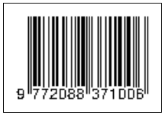Pengukuran Jarak Lubang Pada Benda Padat Menggunakan Sensor Ultrasonik
Ivan Dwicahyo Pratomo(1*), Abdul Rouf(2), Tri Wahyu Supardi(3)
(1)
(2) Department of Computer Science and Electronics, Universitas Gadjah Mada
(3) Department of Computer Science and Electronics, Universitas Gadjah Mada
(*) Corresponding Author
Abstract
The method used for the testing is the echo pulse which produce output of the wave amplitude shown oscilloscope. Function generator as input pulses 40 KHz to circuit amplifier then the transformator strengthened and continued to ultrasonic transmitter. Transmitter generated pulse to object and the pulse has reflection because it has holes an internal object. The reflection pulse is received by the receiver ultrasonic sensor and amplified by signal amplifier circuit, then the wave displayed on oscilloscope.
The research showed that the smaller distance holes testing the wave amplitude obtained becomes larger and when the distance holes a solid object is longer the attenuation coefficient value the greater worth. The value of measurement error in using a tool value made author of 5 %.
Keywords
Full Text:
PDFReferences
[1] Mochalin, J.P. ,1998, Application of Wave Mixing in Photorefractive Materials to Laser Ultrasonics, Cleo, Friday Afternoon, 75 Bd de Mortagne, National Research Council, Canada.
[2] Clorennec, D. , Royer, D. dan Catheline, S., 2002, Saw Propagation on Cylindrical Part Using Laser Ultrasonics: Applications to Crack Detection, IEEE Ultrasonics Symposium, Perancis.
[3] Alfansuri, A. F., 2012, Identifikasi Chilling Injury Buah Alpukat (Persea Americana Mill) dengan Gelombang Ultrasonik, Skripsi, Fakultas Teknologi Pertanian, Institut Pertanian Bogor, Bogor.
[4] Treiber, M., 2008, Characterization of Cement-Based Multiphase Materials Using Ultrasonics Wave Attenuation, Tesis Master of Science in Engineering Science and Mechanics, Georgia Institute of Technology.
[5] Sugito, H. ,Suryono dan Layla, D., 2009, Aplikasi Transduser Ultrasonik Jenis Immersion Transducer untuk Karakteristik Media Cair dan Pengukuran Tingkat Kekasaran Beton, Berkala Fisika, No. 4, Vol. 12, Hal. 137-144.
[6] Subiyanto, L. dan Sardjono T. A., 2012, Deteksi Cacat Pada Material Baja Menggunakan Ultrasonik Non-Destructive Testing dengan Metode Continous Wavelet Transform, Seminar Nasional Teknologi Informasi dan Komunikasi Terapan , Semarang.
[7] Boylestad, R. L., dan Louis Nashelsky. Electronics Devices and Theory. New Jersey: Pearson Prentice Hall. 2006. Pp. 597-637.
Article Metrics
Refbacks
- There are currently no refbacks.
Copyright (c) 2016 IJEIS - Indonesian Journal of Electronics and Instrumentation Systems

This work is licensed under a Creative Commons Attribution-ShareAlike 4.0 International License.
View My Stats1







